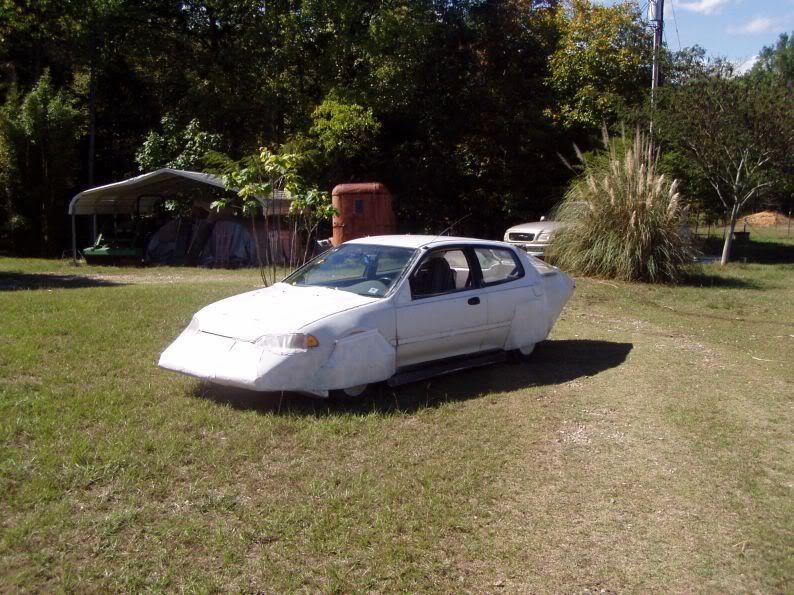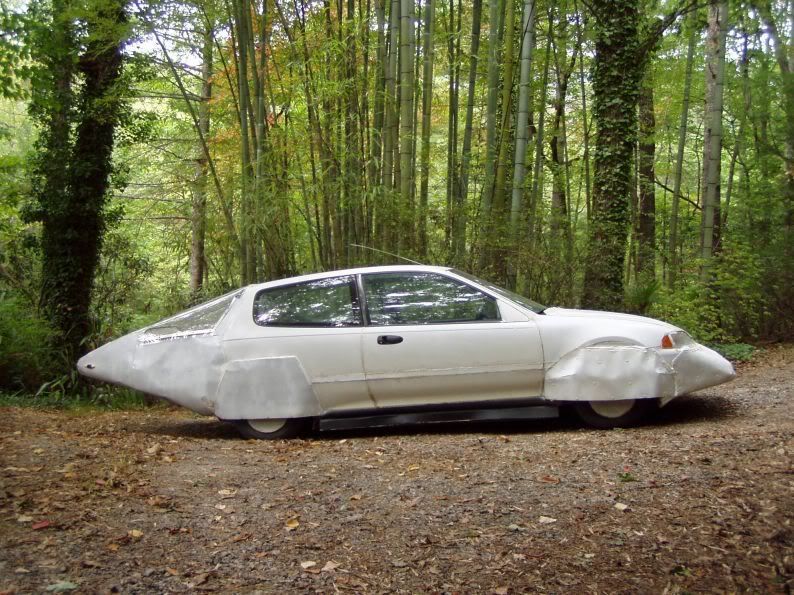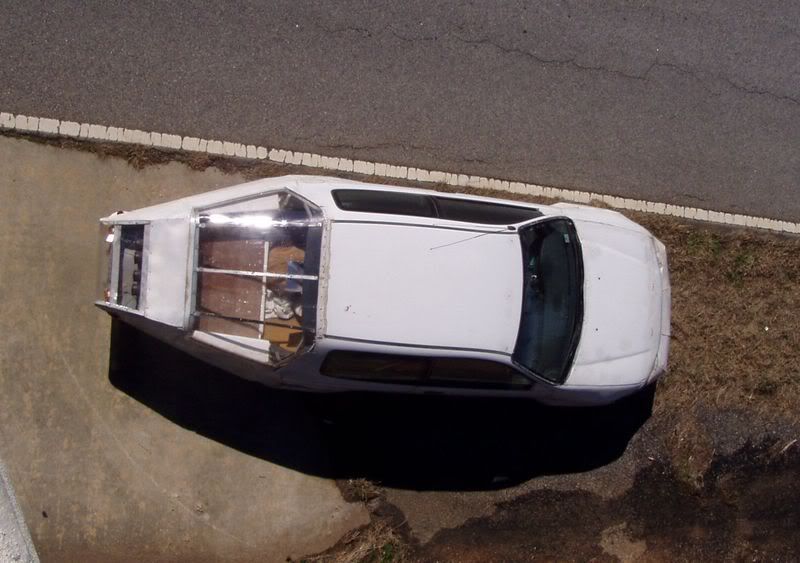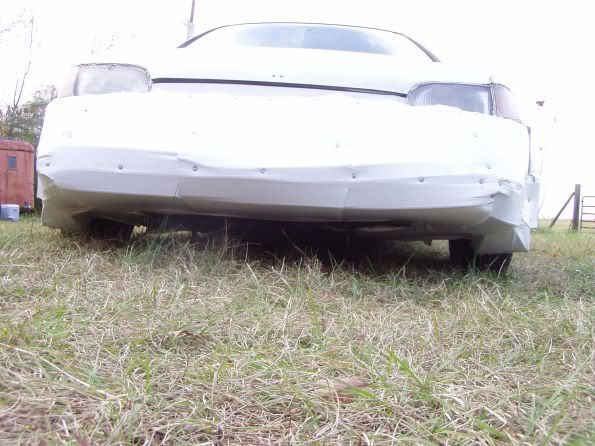 04-07-2008, 01:46 PM
04-07-2008, 01:46 PM
|
#1 (permalink)
|
|
Master EcoModder
Join Date: Mar 2008
Location: USA
Posts: 568
Thanks: 1
Thanked 73 Times in 58 Posts
|
Car face/nose/bumper cover aerodynamics
Does anybody here know of any studies or designs that optimize the aerodynamics of a car face/nose/bumper cover?
As the surface that first meets the oncoming airstream, the car's face is probably the most important feature for aerodynamic efficiency, just as the leading edge of an airfoil is the most critical part of a wing.
The face has to house and position the cooling inlet(s), headlights, turn signals, and perhaps spoiler/splitter/wheel fairings/deflectors.
So, what face(s) are most efficient? Got pics or cites?
I may re-do the face on my old Porsche 944 Turbo, and would like some good benchmarks as design cues. Suggestions?
|
|
|

|
 Today Today
|
|
|
|
 Other popular topics in this forum...
Other popular topics in this forum...
|
|
|
|
 04-07-2008, 02:03 PM
04-07-2008, 02:03 PM
|
#2 (permalink)
|
|
Administrator
Join Date: Dec 2007
Location: Germantown, WI
Posts: 11,203
Thanks: 2,501
Thanked 2,589 Times in 1,555 Posts
|
The front really isn't as important as the back to be honest. Relatively small changes to the radius transition from the bumper cover to the hood keep the airflow attached. The same can be said for the transition between the bumper cover and underside (assuming your using a bellypan) and sides of the vehicle.
If you post some pictures we can recommend some things probably.
|
|
|

|
 04-07-2008, 02:31 PM
04-07-2008, 02:31 PM
|
#3 (permalink)
|
|
Master EcoModder
Join Date: Mar 2008
Location: USA
Posts: 568
Thanks: 1
Thanked 73 Times in 58 Posts
|
Quote:
Originally Posted by Daox

The front really isn't as important as the back to be honest. Relatively small changes to the radius transition from the bumper cover to the hood keep the airflow attached. The same can be said for the transition between the bumper cover and underside (assuming your using a bellypan) and sides of the vehicle.
If you post some pictures we can recommend some things probably.
|
I dunno. In aircraft (especially sailplane) design, the nose contour and texture is quite critical, as buggered airflow there means the rest of the plane is moving into already turbulent and detached flow. The more recent Porsche designs such as Carerra GT and 911 series feature smooth and conformal lines from the nose stagnation point on back, for the best penetration.
I'm not good with posting pictures, but will try and put one up.
Basically, I'd like to consolidate all drag and turbulence-makers such as turn signal lenses, headlights, etc. into streamlined and conformal locations, and have one cooling inlet at the stagnation point, rather than separate intake holes here and there. In other words, as little form drag as possible, although bug splatter and rock chips are a given that eliminate any laminar flow. Turbulent but attached flow seems possible, though, with efficient contour. |
|
|

|
 04-07-2008, 10:02 PM
04-07-2008, 10:02 PM
|
#4 (permalink)
|
|
Master EcoModder
Join Date: Dec 2007
Location: Upstate SC
Posts: 1,088
Thanks: 16
Thanked 677 Times in 302 Posts
|
The nosepiece I put on the front of my car made a noticable improvement in coasting ability (this was in my pre-SuperMID days). It also reduced the number of smashed bugs and birds on the front of my car to almost zero (prior to this I was always having to scrub dried bugs and occasional feather off the flat front bumper).
|
|
|

|
 04-08-2008, 01:09 AM
04-08-2008, 01:09 AM
|
#5 (permalink)
|
|
Master EcoModder
Join Date: Mar 2008
Location: USA
Posts: 568
Thanks: 1
Thanked 73 Times in 58 Posts
|
Quote:
Originally Posted by basjoos

The nosepiece I put on the front of my car made a noticable improvement in coasting ability (this was in my pre-SuperMID days). It also reduced the number of smashed bugs and birds on the front of my car to almost zero (prior to this I was always having to scrub dried bugs and occasional feather off the flat front bumper).
|
Got pics?
The streamlined nose sheds the stagnation air better, making for a smaller stagnation point in the first place. Good shedding of stagnant air is why your car collects few bug splatters, and also why your car is about as efficient as any car ever was.
The ultimate in efficiency is a high performance German sailplane, such as an ASW-22. They pay great attention to forward fuselage design and contour of the nose, since the rest of the aircraft follows in the wake of the nose. Same story with boats. The nose is the most critical part.
So, who has nose mod suggestion or scientific data? |
|
|

|
 04-08-2008, 01:07 PM
04-08-2008, 01:07 PM
|
#6 (permalink)
|
|
EcoModding Lurker
Join Date: Apr 2008
Location: SF Bay Area
Posts: 35
Thanks: 0
Thanked 3 Times in 3 Posts
|
You have to be very careful when transferring your knowledge of airplanes to cars.
Airplanes (especially sailplanes) are highly optimized to begin with--they've already taken care of a lot of the base drag by tapering (boat-tailing) the wings and fuselage. That hasn't been done with cars (to the same extent). Accordingly, it is worthwhile *on an airplane* to spend a lot of time on the nose because they've already taken care of the all the parts that are worse.
Second, when it comes to wings (and even the nose), the airplane folks care about lift and are usually trying to either maximize lift (which we're trying to minimize if we even care at all) or maximize the lift/drag ratio. We're (usually) just trying to minimize drag. The difference in goals affects the approach one takes--it may well be the case that the front of the wing (given what I've said above about the trailing half of the wing) is (now) the most important area from the point of view of *lift*. It is clearly *not* the most important part of a typical car from the point of view of *drag*--the rear is because (generally) the largest single drag compoent is base drag.
Third, when you consider the front of the car, you can't just optimize that part in isolation from the others--as you point out with airplanes, what happens there affects what happens downstream. Aerodynamicists treat the front of the car as an integral part of the whole and when they consider mods to the front, they consider what it does to the air flow (and therefore the drag and lift) elsewhere. It is often the case that by making the front have a lower Cd (considered in isolation), they affect the airflow around the car (and especially under the car) in ways that *increases* the drag elsewhere. You have to treat the whole car as a *system* and optimize for overall reduction of Cd.
Fourth, for the reason I just mentioned, there is likely no one *optimal* front end design--there are front ends that work well with particular "back ends" (the part from the front axle all the way to the rear) and front ends which don't. The front end design you pick will depend, in part, on the back end you already have (or plan to make). This is true also with airplane wings and airplane fuselages: you can't just take the front end of your sailplane and put it on a Cessna and expect it to produce good results. Ditto for the leading edges of wings--the whole wing, the whole plane has to be considered.
--Steve
|
|
|

|
 04-09-2008, 05:33 PM
04-09-2008, 05:33 PM
|
#7 (permalink)
|
|
Master EcoModder
Join Date: Dec 2007
Location: Upstate SC
Posts: 1,088
Thanks: 16
Thanked 677 Times in 302 Posts
|
[QUOTE=Otto;18395]Got pics?
The streamlined nose sheds the stagnation air better, making for a smaller stagnation point in the first place. Good shedding of stagnant air is why your car collects few bug splatters, and also why your car is about as efficient as any car ever was.
QUOTE]
Here are some pics of my car. The stagnation point is 12" above the road. The radiator air inlet is that little slot next to the passenger side headlight in the first photo and goes about 2/3 of the way between the two headlights.
 

Also someone asked in one of the recent threads why many front wheel spoilers/air splitters deflect the air downward rather than from side to side. Splitting the air would be somewhat more efficient (except for the slight increase in interference drag with the underside of the car) than compressing the air downwards against the road. But a pure side to side air splitter (shaped somewhat like the mini-boattails behind my rear wheels) would be less forgiving of impacts with road debris. The ideal shape would be a rounded cone of a rubbery material, but the one on my car is a flared rectangle for ease of construction out of coroplast (I used coroplast rather than aluminum sheet for underbody structures ahead of the wheels for its resiliency to impacts with dead possums and the like). This pic is an older one taken before I converted the nosepiece from coroplast to aluminum.
 |
|
|

|
 04-09-2008, 05:52 PM
04-09-2008, 05:52 PM
|
#8 (permalink)
|
|
Master EcoModder
Join Date: Jan 2008
Location: Sanger,Texas,U.S.A.
Posts: 16,434
Thanks: 24,483
Thanked 7,411 Times in 4,801 Posts
|
Car face/nose.......................
Hucho's book has the complete development of the "ideal" nose by Volkswagon,including windtunnel photos.Chrysler Aerospace beat them to the punch in 1967,when they developed the front for the NASCAR Dodge Daytona which swept the field.MG beat Chrysler in the 50s with their EX "pumpkin seed".Bucky Fuller beat MG in the 1930s.The list goes back 500-million years.Go to an Asian market and buy a frozen mackeral.That fish will tell you all you'll ever need to know about streamlining.
__________________
Photobucket album: http://s1271.photobucket.com/albums/jj622/aerohead2/
|
|
|

|
 04-09-2008, 08:37 PM
04-09-2008, 08:37 PM
|
#9 (permalink)
|
|
EcoModding Apprentice
Join Date: Feb 2008
Location: Italy, Morbegno (SO)
Posts: 151
Thanks: 9
Thanked 38 Times in 18 Posts
|
All you have write rigth, and all considerations about the importance fo rearend compared whit the frontend are on line wiht theories.
but the Otto dubts does are infondati.
Perhaps, Otto intends to say that the drag contribution of frontend includes also the interference of front wheels and cooling, not only the dynamic pressure.
I would like to ask at Basjoos, what would happen to his FE if he would remove all changes at frontend, and what would happen to his FE (or Cd) if he would remove all mods at the rearend.
__________________
.................................................. ...................
|
|
|

|
 04-09-2008, 08:50 PM
04-09-2008, 08:50 PM
|
#10 (permalink)
|
|
EcoModding Apprentice
Join Date: Feb 2008
Location: Italy, Morbegno (SO)
Posts: 151
Thanks: 9
Thanked 38 Times in 18 Posts
|
Otto, Which model of 944, have you?
I you are problem to put image of your car, link the image from this site: http://www.marcel.nl/944/
__________________
.................................................. ...................
|
|
|

|
|